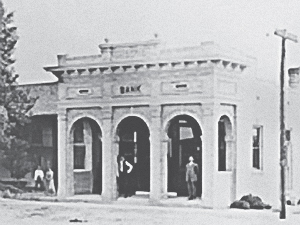Small town, big history

By the 20th century, the Town of Elizabeth boasted a vibrant business district, including this bank pictured above. Today, Elizabeth is a bedroom community for those wanting a small-town experience.
Elizabeth, Colorado, the largest town in Elbert County, has an interesting history. Originally a sawmill camp called Russellville, the settlement was established in 1855 near the banks of Running Creek. Gold was discovered near the creek in 1858 and a rush ensued, but it never came to a boom.
When Running Creek flooded the campsite, the town moved to where it is today and was renamed and incorporated as Elizabeth in 1890. Good news happened in 1891when Colorado Governor John Evans developed the Denver & New Orleans Railroad (D&NO), which was the first railway to run from Denver to Colorado Springs to Pueblo – passing near Elizabeth. The railway was originally intended to be a transport to the Gulf of Mexico but was subsequently changed to Fort Worth.
By the 20th century, Elizabeth boasted churches, a school and several businesses, to include a creamery. The local industry centered around farming, cattle ranching, dairy farming and logging.
In the 1920s, however, cattle prices plunged followed by the national depression in the 1930s. To make matters worse, the railroad near Elizabeth was flooded in 1935 which added to the economic decline. That year, the population dropped from 326 citizens down to 250.
Improvements in transportation in the 1960s helped the economy to improve, and as the Denver and Colorado Springs areas grew, Elizabeth began to shift from a more agricultural community to a residential one.
Today, Elizabeth is a bedroom community for those who want a small-town atmosphere and are willing to commute. Although it’s growing, the population is right around 1,700.
By Hollen Wheeler; photo courtesy of the Town of Elizabeth